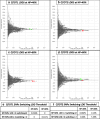Novel caries loci in children and adults implicated by genome-wide analysis of families
- PMID: 29859070
- PMCID: PMC5984765
- DOI: 10.1186/s12903-018-0559-6
Novel caries loci in children and adults implicated by genome-wide analysis of families
Abstract
Background: Dental caries is a common chronic disease among children and adults alike, posing a substantial health burden. Caries is affected by multiple genetic and environmental factors, and prior studies have found that a substantial proportion of caries susceptibility is genetically inherited.
Methods: To identify such genetic factors, we conducted a genome-wide linkage scan in 464 extended families with 2616 individuals from Iowa, Pennsylvania and West Virginia for three dental caries phenotypes: (1) PRIM: dichotomized as zero versus one or more affected primary teeth, (2) QTOT1: age-adjusted quantitative caries measure for both primary and permanent dentitions including pre-cavitated lesions, and (3) QTOT2: age-adjusted quantitative caries excluding pre-cavitated lesions. Genotyping was conducted for approximately 600,000 SNPs on an Illumina platform, pruned to 127,511 uncorrelated SNPs for the analyses reported here.
Results: Multipoint non-parametric linkage analyses generated peak LOD scores exceeding 2.0 for eight genomic regions, but no LOD scores above 3.0 were observed. The maximum LOD score for each of the three traits was 2.90 at 1q25.3 for PRIM, 2.38 at 6q25.3 for QTOT1, and 2.76 at 5q23.3 for QTOT2. Some overlap in linkage regions was observed among the phenotypes. Genes with a potential role in dental caries in the eight chromosomal regions include CACNA1E, LAMC2, ALMS1, STAMBP, GXYLT2, SLC12A2, MEGF10, TMEM181, ARID1B, and, as well as genes in several immune gene families. Our results are also concordant with previous findings from association analyses on chromosomes 11 and 19.
Conclusions: These multipoint linkage results provide evidence in favor of novel chromosomal regions, while also supporting earlier association findings for these data. Understanding the genetic etiology of dental caries will allow designing personalized treatment plans based on an individual's genetic risk of disease.
Keywords: Dental genetics; Dental public health; Genome-wide linkage study; Non-parametric linkage; Permanent dentition caries; Primary dentition caries.
Conflict of interest statement
Ethics approval and consent to participate
All subject recruitment and data collection was approved by the site-specific Institutional Review Boards listed below. At each site, written consent to participate was obtained from all study subjects.
COHRA participants: University of Pittsburgh Institutional Review Board and West Virginia University Institutional Review Board.
IHS participants: University of Iowa Institutional Review Board.
IFS participants: University of Iowa Institutional Review Board.
DRDR participants: University of Pittsburgh Institutional Review Board.
Competing interests
The authors declare that they have no competing interests.
Publisher’s Note
Springer Nature remains neutral with regard to jurisdictional claims in published maps and institutional affiliations.
Figures



References
-
- Chou R, Cantor A, Zakher B, Mitchell JP, Pappas M: Prevention of Dental Caries in Children Younger Than 5 Years Old: Systematic Review to Update the U.S. Preventive Services Task Force Recommendation. Evidence Synthesis No. 104. ; 2014. - PubMed
-
- Morrison J, Laurie CC, Marazita ML, Sanders AE, Offenbacher S, Salazar CR, Conomos MP, Thornton T, Jain D, Laurie CA, et al. Genome-wide association study of dental caries in the Hispanic communities health study/study of Latinos (HCHS/SOL) Hum Mol Genet. 2016;25(4):807–816. doi: 10.1093/hmg/ddv506. - DOI - PMC - PubMed
Publication types
MeSH terms
Grants and funding
LinkOut - more resources
Full Text Sources
Other Literature Sources
Medical

